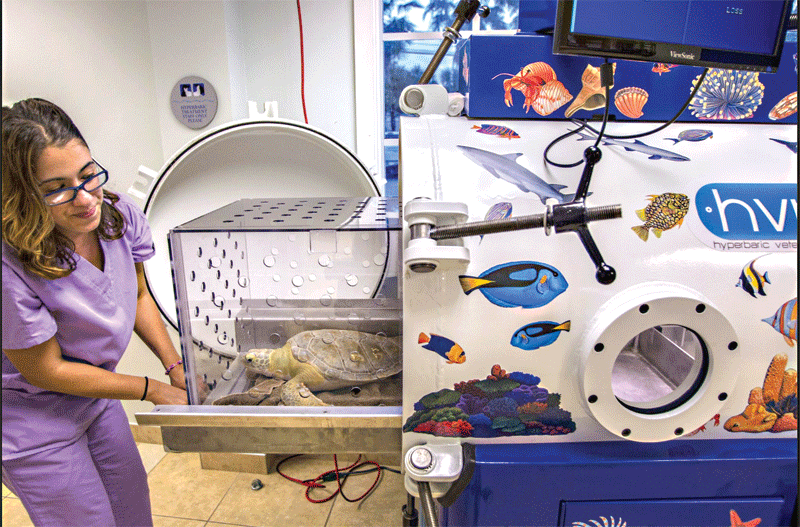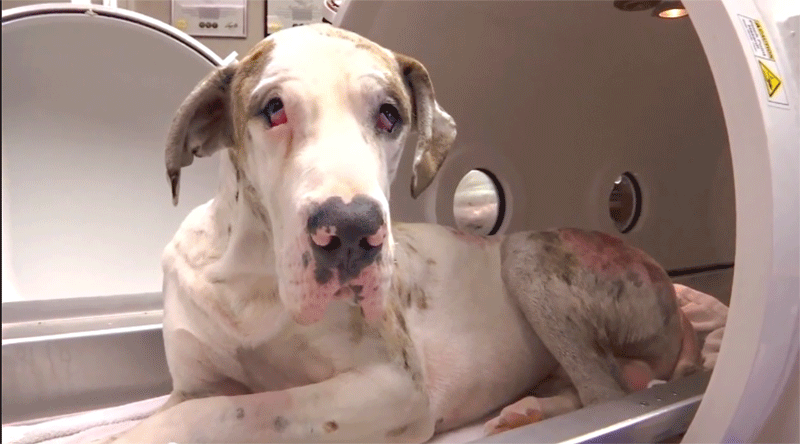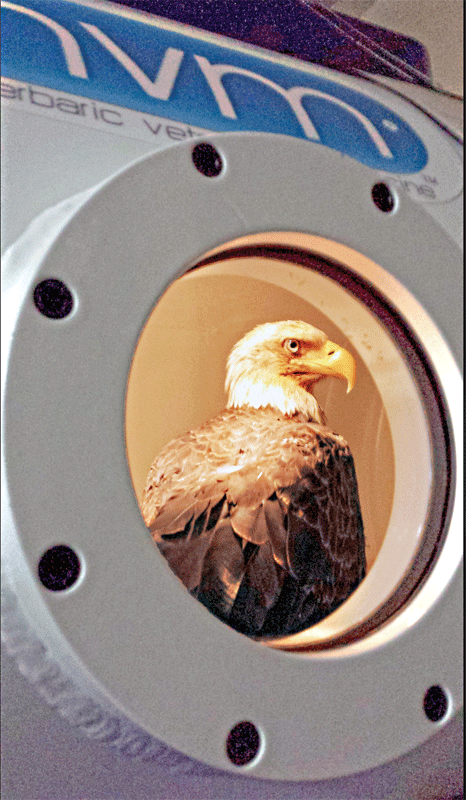
Photos courtesy Hyperbaric Veterinary Medicine
Veterinarians looking to improve their rehabilitative care services have increasingly more options to choose from—hydrotherapy, laser therapy, and now, pressurized oxygen therapy. With this simple, yet effective technology, hyperbaric chambers can help patients recover from both common and life-threatening traumas.
Overview
Since its introduction into the veterinary industry in roughly 2015, hyperbaric oxygen therapy (HBOT) has seen growth and adoption. According to manufacturers, they no longer get the question, “What’s that?” Instead, they get, “Can you give me more information?” and, “Can I see some case studies?”
HBOT enhances and accelerates treatment and healing, and it can be used for different issues, including severe tissue damage, such as burns, inflammatory responses, and pressure necrosis wounds (sparing amputation for one patient), getting blood into places where it does not get to otherwise.
When a patient is in a session (or a “dive”) within the chamber, the increased pressure causes oxygen uptake by the cells, tissues, glands, organs, brain, and all fluids of the body. At 2.0 atmospheres, for example, oxygen is being delivered to the patient’s tissues at a rate of 20 times than normal breathing air. This oxygen can then be utilized by the body for healing.
The idea has become mainstream and implementation into facilities is growing. Many urgent and emergency care facilities, as well as practices with interest in rehabilitative care, are adopting it. Southeastern Guide Dogs uses it to decompress their training dogs. The Australia Zoo has been using it, especially during the catastrophic 2019-2020 bushfire season, treating koalas and other patients suffering from dehydration, burn injuries, smoke inhalation, and starvation. As well, manufacturers have been tapped to design specialized chambers for equine hospitals, loggerhead sea turtles, and bovine at high altitudes.
How it works
The strategy is simple because oxygen is beneficial for wounds or injuries. HBOT works by diffusing the oxygen molecules and getting them deep into the affected tissue to accelerate healing.
Andrew Turkell, DVM, CVA, CCRT, CHT-V, of Calusa Veterinary Center in Boca Raton, Fla, pioneered the therapy when he added it to his practice 12 years ago and has seen the benefits firsthand. Dr. Turkell recently used pressurized oxygen to help a dog with painful pancreatitis.
“The dog went in with a splinted abdomen, wouldn’t lie down and was extremely uncomfortable,” Turkell said. “Once he got in there and started to feel comfortable under pressure, breathing 100 percent oxygen, he lay down and just became much more relaxed. That dog came out of the chamber after an hour and had something to eat.”
Looks like a submarine, works holistically

The chamber looks like a small submarine and takes up only about a 4 feet x 3 feet space. When in use, oxygen is pressurized and saturates the affected tissues, promoting healing for a much speedier recovery.
Turkell likens the way it works to a bottle of soda. “When you go into a chamber and you’re forcing a gas down into your breathing mechanism and that gas is oxygen, the force of oxygen is pushed into the liquid part of your blood. It’s just like when CO2 is pushed into the Coke syrup and water of a bottle of Coke,” Turkell explains. “You can’t see those bubbles when you look at the bottle before the cap is off,” he adds. “But what happens is you’re forcing oxygen into the liquid part of the blood—the plasma—and that liquid part of the blood travels all through your body. The plasma bridge carries the oxygen to the tissue and that’s part of the magic.”
Turkell has seen how hyperbaric therapy helps his patients with an array of issues including crush injuries from car accidents, bite wounds, surgical recovery, and more. “We use it in house fires where pets have been exposed to carbon monoxide. At the same time, acute blood loss, acute trauma with inadequate blood flow to tissues, compromised skin grafts and flaps, and bone infections are aided with hyperbarics, too.”
Adding to the long list of conditions that benefit from hyperbaric therapy, Turkell has also used it to treat gastric dilatation volvulus that otherwise might need surgical intervention.
“As the stomach is enlarging and becoming ischemic because it’s twisted, you may cut that animal to end the torsion,” says Turkell. “But based on how long the stomach was twisted, you very well may improve the maximum medical recovery of that patient and improve the tissue that has been hypoxic and ischemic and inflamed just by pouring oxygen to the plasma of that patient. And you may see a much quicker recovery.”
Patient experience
Animals appear to feel comfortable in the chamber, and when it is time for their therapy, they hop in and have a good rest. When they emerge, they are full of energy because they feel better.
“Dogs are wolves, and by nature, they are denning animals,” said Turkell. “They like something that’s cave-like, and most of the time they curl up and go to sleep. Once a dog—or any animal—has gone in the first time, many of the patients come in for their daily treatment and they run into the hyperbaric room and they’ll put their feet up on the chamber door, getting ready to go in. They don’t need to be sedated. It’s very calming.”
Not surprisingly, since hyperbaric chambers were originally developed for humans, they needed some design changes when converted for veterinary use. The chambers were made more rigorous for daily animal use, and they were reduced in size to about 60 percent to 70 percent of human chambers.
Uncommon patients

Veterinarians are just seeing the tip of the iceberg when it comes to conditions treated with oxygen therapy. As a veteran with 40 years of animal health experience, Turkell was still surprised by one of his treatment experiences. He found himself saving critically endangered Kemp’s ridley sea turtles by stacking them into the chamber after they had been stunned by a cold snap last winter. Pressurized oxygen therapy helped the turtles recover.
Another unusual use can be found in the story of Louie the seahorse, treated at the University of Florida College of Veterinary Medicine for gas bubble disease—similar to the bends for scuba divers.
According to an article on the university’s UF Health website,1 Tatiana Weisbrod, DVM, MS, a resident with the UF aquatic animal medicine program, said, “Hyperbaric treatment has mostly been used in aquatic medicine for treating barotrauma in fish brought up from deep waters during events like collection dives rather than explicitly for treatment of gas bubble disease in privately owned fishes.”
Dr. Weisbrod further explained, “Based on my discussions with other aquatic vets, our integrative team and a lot of research, I felt comfortable offering this as a treatment option to Louie’s owner.”
Louie the little seahorse came through his treatment well and helped his veterinary team pioneer this therapy, just as Turkell is pioneering it at his Boca Raton practice. Success stories like these offer the prospect of improved outcomes for more patients than ever before. When an animal needs rehabilitative therapies, veterinarians have several treatment options to increase mobility and promote healing. Many of them can be combined with exercise and the use of a range of drugs to give the result.
For Turkell, pressurized oxygen therapy is another tool to add to a healing regimen. Patients are sometimes treated daily, depending on the issue. “Hyperbaric is just another drug. It’s using oxygen under pressure as a drug,” he explained.
Sharaya Guerrero has been with Patterson Veterinary since 2017 and supports the company’s equipment and technical services. Prior to that, she was a Certified Veterinary Technician in general practice and emergency medicine.
Reference
- Carey S. UF vets use novel treatment to save Louie, the trailblazing seahorse. UF Health. November 30, 2020. https://ufhealth.org/news/2020/uf-vets-use-novel-treatment-save-louie-trailblazing-seahorse?fbclid=IwAR2ewkDaDbqPWbHIgau9tfMKjTaxqV-CICBNPrkIYrc3QEFK-5rgvLdywAA
